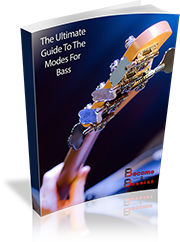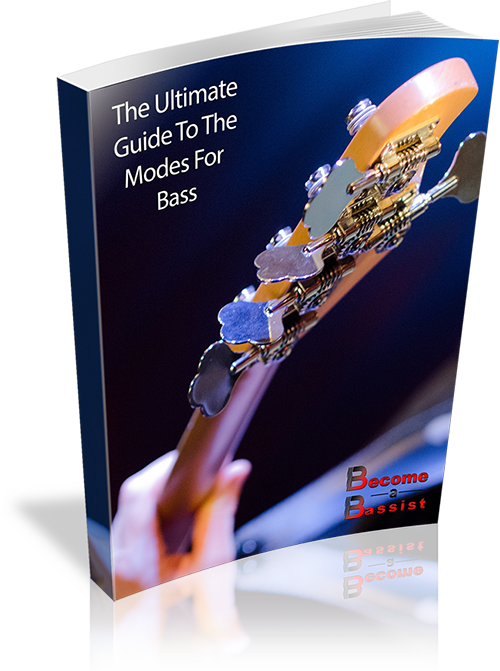A curious thing happens when a bass player learns the major modes. They soon find themselves wondering about the minor modes on bass as well.
This is completely natural! Most people only talk about the major modes, but what if you’re playing a song in a minor key?
Do the same rules apply? How do you get the modes of a minor key? Are ‘new’ modes something you have to spend time learning now?
It’s actually much simpler than that. In fact, if you know the major modes, you already know the minor modes!
That’s right – they’re the same modes, just in a different order, and that’s exactly what you’ll learn about in today’s lesson.
Before you check this one out though, you need to have a solid understanding of the major modes. Without that, I’m afraid this video won’t make a whole lot of sense.
If you haven’t already, take a look through my Ultimate Guide To The Modes For Bass, then come back to this video. I promise, this lesson will be much easier to follow when you have that solid foundation.
Check out the lesson here:
Video Not Showing Up Here? Watch On YouTube

Stop Struggling With The Modes On bass
FREE - Download the 16-page Ultimate Guide To The Modes Of The Major Scale For Bass and:
- Get a full explanation of the modes in simple, easy-to-understand terms
- Discover how the modes REALLY work and how they're related to different chords
- Learn how to use the modes, and where you can use each of them
- Download the free PDF guide plus 24 practice tracks that will have you using the modes TODAY
As far as how to think about the minor modes and their chord relationships, there are two ways of doing it.
Some people prefer to translate everything into the major key and work everything out from there.
Others would rather just treat the tonic of the minor key as the ‘1-chord’. This means you can have the exact same chord progression and different people thinking about it in very different ways, but it would still work.
For example, if you had this chord progression:
Em – Am – D – Em
You could think of it as either:
1 – 4 – 7 – 1 (if you’re thinking in terms of E minor)
Or:
6 – 2 – 5 – 6 (if you’re thinking in G major)
How you think about everything is up to you. There are no wrong answers when it comes to how you think about the minor modes on bass. As long as the right sounds come out, it’s all good!
As always, if you have any questions, just let me know by leaving a comment below. I’m happy to help out however I can.
Good luck with the lesson and happy playing!
Cheers,




I’m so happy find. After vigorously practicing your lessons within these few days my bass playing has improved tremendously. Yesterday evening I prayed bass in my church it was unbelievable. I will never stop following you. Thanks. I now need help on improvising, and some techniques
That’s amazing Brantuo! I’m happy the lessons are working for you. If you’re looking for improv help, I’d recommend these two lessons:
https://becomeabassist.com/bass-solo-how-to-improvise-on-bass/
https://becomeabassist.com/how-to-play-more-melodically/
Thank you for doing a video around my question! I really like the modes that makes
it so much easier to create a riff or a bass line “on the fly”.
The modes has improved my playing sooooo much!
//Lasse
No worries at all Lasse – thanks so much for asking the question in the first place! I’m glad to hear your playing is seeing improvements as well – that’s always good news!
Took a while to finally see the connection. I think of it as a scale degree shift. The 3d on the minor is the 1st of the major and thus Ionian, if you follow that kind of rationalization. Works for the shapes of the major and minor pentatonics as well. Great info.
thank you Luke
help me very much
Luke,
New to your site and enjoying very much. I’m still trying to grasp how to match the mode to the chord. I’m playing along with a computer jam covering Em9, Am9, C7 and B7. Figured out mixolydian for the C7 and B7 (I think) but not sure how to line up with the first two. Thanks for all you do. Cheers, Andy
This is a great question Andy, and a bit more complicated than it may appear on the surface. In general, if all the chords are from a single key, it’s very easy to match modes to chords. For example, if you had the key of G major and had a G chord, C chord and D chord, you could very easily map G Ionian, C Lydian and D Mixolydian to those chords.
The chords in your example though DON’T all come from the same key. That being said, they’re all ‘roughly’ in E minor. If it were me, I’d match the E minor with E Aeolian, the A minor with A Dorian because they both come from the key of E minor.
However, the C7 doesn’t exist in the key of E minor. The notes of the chord are C, E G and Bb. C, E and G are in the key, but not Bb. What you can do though for this chord is fill in the ‘gaps’ of the chords with notes from the key. So C is in the chord, D (scale tone) E (chord tone) F# (scale tone) G (chord tone) A (scale tone) Bb (chord tone) and C on top. That gives you something called C Lydian Dominant:
C-D-E-F#-G-A-Bb-C
It’s exactly what it sounds like – a Lydian scale with a flat 7. You could also think of it as being C Mixolydian with a sharp 4. You technically ‘could’ use just a regular C Mixolydian, but you’d end up playing F’s, which are the flat 2 of the key, so they may not sound great.
The B7 chord is trickier still, because again, it doesn’t exist in key of E minor. It’s ‘borrowed’ from elsewhere. One possibility is to think of it as being the 5th chord in E harmonic minor, so you can use the 5th ‘mode’ of that scale:
B-C-D#-E-F#-G-A-B
This keeps everything in the key, but still outlines the chord. Using a regular Mixolydian will give you C#’s, G#’s and A#’s – all notes from outside the home key of E minor. This is just one way of dealing with this particular chord, but try it out and hopefully you’ll hear how it keeps everything ‘inside’ the key.